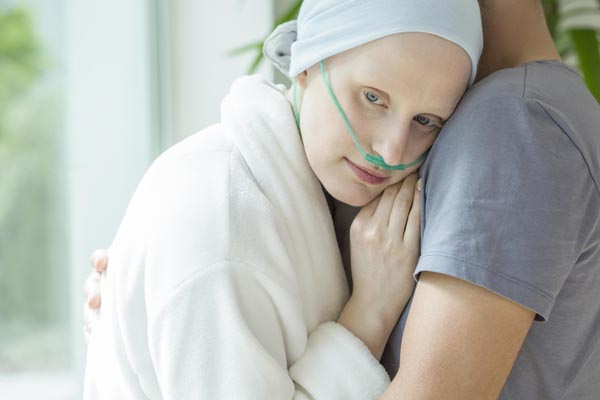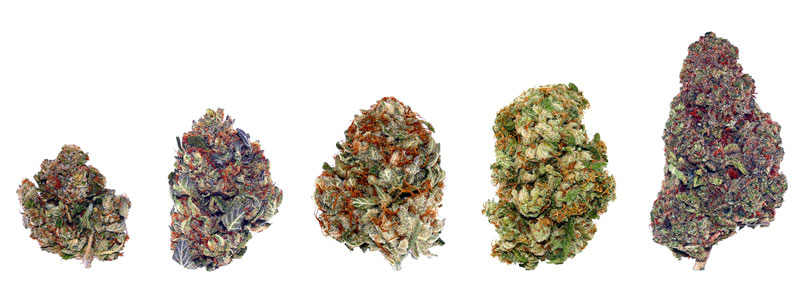Cancer
Three words that you never want to hear from a healthcare provider: “You have cancer.”
 The moment after this diagnosis has been made, your heart sinks and it feels as though all hope has been lost.
The moment after this diagnosis has been made, your heart sinks and it feels as though all hope has been lost.
This disease can leave many people feeling demoralized and frightened of the future. Five year survival rates can range from as low as 9% to as high as 98%, depending on the type of cancer.
Thankfully, current scientific and medical research have made cancer more treatable than ever before and have also opened the doors to new treatment options that people did not have access to previously.
One of these newer and alternative treatment options that patients are finding success with is medical cannabis.
From treating the side effects of modern medical treatments like chemotherapy, radiation therapy and immunotherapy to showing promise for reducing and inhibiting the growth of cancerous tumors, medical cannabis can have benefits in multiple areas of cancer therapy.
In this article, we are going to look at some of the symptoms associated with cancer, cancer therapy, and how medical cannabis can help alleviate or reduce those symptoms.
Here at Kanteeva it is our goal to provide you with the information that you will need to make an educated decision on whether medical cannabis is an option for your individual needs. After reading this article you should have a basic understanding about medical cannabis and how it may be able to benefit people suffering from cancer. It is our hope that having this knowledge will allow you to further discuss your medical options with your healthcare provider(s).
After reading this article if you have any additional questions or concerns, please leave them in the comment area below and a Kanteeva team member will respond back to you as soon as possible.
What Is Cancer?
MedicineNet defines cancer as:
An abnormal growth of cells which tend to proliferate in an uncontrolled way and, in some cases, to metastasize (spread).
Cancer treatment and therapy can be very complicated.
MedicineNet states that:
Cancer is not one disease. It is a group of more than 100 different and distinctive diseases.
Even though more than 100 different diseases are classified as “cancer,” many of them share similar treatment options. This article focuses on the common treatment methods that are currently being used for treating a variety of different cancers.
Also, while there are more than 100 different diseases classified as cancer, the Cleveland Clinic lists 7 different warning signs that may be symptoms of cancer and advises people to see their healthcare provider(s) when any of these 7 signs are observed:
- Change in bowel or bladder habits
- A sore that does not heal
- Unusual bleeding or discharge
- Thickening or lump in the breast or elsewhere
- Indigestion or difficulty in swallowing
- Obvious change in a wart or mole
- Nagging cough or hoarseness
It is important that you remember that while these 7 signs do often present as warning signs of some cancers, other cancers are not associated with any of them. You should always consult with your healthcare provider(s) for specific warning signs that may be observed based on your own family history and lifestyle.
How Is Cancer Currently Treated?

Thanks to modern medicine, there are numerous different treatment options available for most types of cancer. Treatments often vary significantly depending upon what type of cancer is being treated. However, there are many different forms of cancer that are treated with very similar therapies, with 3 to 5 different primary approaches.
Typically, cancer is treated by utilizing a combination of surgery, chemotherapy and radiation therapy. Specific forms of cancer may also be treated by using hormone therapy, immunotherapy, and bone marrow transplant.
Often the best approach to cancer treatment is found in surgery that is designed to remove cancerous cells from the body, with the hope that surgery will eliminate the cancerous cells from coming back in the future. When surgery is an option it can often be very successful when compared to other treatment methods. When it comes to your own individual treatment options it is important to discuss all options with your healthcare provider(s) before trying to choose one on your own.
Thanks to all of the research that has been conducted in various fields of study on cancer therapy, modern medicine has more options than ever before for treating many different types of cancer. However, many of these options come with significant side effects that you need to be aware of before beginning therapy.
Can Cannabis Help Alleviate the Side Effects of Modern Cancer Treatments?

The problem with many of the existing cancer treatment options is that they produce side effects that can vary in severity from very minor to life-threatening or even fatal.
Many of the side effects associated with existing cancer therapy options can be treated with medical cannabis.
Medical cannabis is a viable option to help patients who are suffering through cancer therapy, allowing them to be more comfortable.
Below are some of the side effects associated with cancer therapy, as well as a summary on how medical cannabis can help to alleviate them.
Fatigue
Feeling overwhelmingly tired is one of the most common symptoms of cancer, as well as a side effect from many cancer treatments. While little research has been produced that shows cannabis as being able to help with the symptoms of chronic fatigue, many patients in the medical cannabis community have stated that many Sativa strains of cannabis have been able to help them find more energy and focus throughout the day.
Loss of Appetite
Both cancer and cancer treatment options like chemotherapy and radiation therapy are known to cause a decrease in appetite. Many different cannabis strains are known for causing appetite stimulation, referred to as “getting the munchies.” Often when it comes to cancer therapy and loss of appetite, medical cannabis has been described by patients as being an appetite booster that helps them eat, restoring their strength and allowing for a much better quality of life overall during their battle with cancer.
Insomnia
Receiving a diagnosis of cancer and undergoing therapy for cancer are both reasons that many people may be unable to sleep at night. Aside from the stress that cancer therapy can often cause, other issues like pain, nausea and general restlessness can make it very challenging to sleep. Medical cannabis has been shown to help with symptoms of insomnia and if you would like to know more please read our Kanteeva article on insomnia and medical cannabis.
Nausea
Cancer and many cancer therapy options can cause people to develop severe feelings of nausea. This nausea is often exacerbated even further by the pain associated with different forms of cancer. Medical cannabis has been recognized for many years as being able to help calm nausea and increase your appetite. There are also two Cannabinoid Based Medications (CBM), dronabinol and nabilone, that are frequently given to people undergoing chemotherapy to help reduce nausea and vomiting.
Pain
One of the most common symptoms of cancer and one of the most frequently observed side effects of cancer therapy is pain. Many pain medications come with side effects like nausea and loss of appetite, which only add to overall discomfort and pain of the patient. There have been many patients who have found successful pain relief from the symptoms associated with cancer and cancer therapy by using medical cannabis. If you would like to learn more about how medical cannabis may be able to help you alleviate pain please see our Kanteeva article, “Chronic pain and Medical Cannabis.”
Neuropathy
Neuropathy is a medical term used to describe nerve damage and is a common complication of chemotherapy and other cancer treatments. Unfortunately, this condition is often accompanied by feelings of weakness, numbness, tingling, burning in the hands and feet, and severe pain. Medical cannabis has been shown to help provide relief to patients experiencing the symptoms of neuropathy. Many members of the medical cannabis community claim that medical cannabis can alleviate nerve pain and sciatica significantly.
These are just a few of the different side effects that many people face when undergoing cancer therapy. Depending upon the type of therapy being used side effects can vary significantly.
Now that you have a better understanding of how medical cannabis can help treat some of the side effects associated with a variety of different cancer therapies, let us look at the science behind medical cannabis and how it may be effective at treating cancer.
What Does Science Say about Medical Cannabis and Cancer?

For instance, recent animal studies have shown that marijuana extracts may help kill certain cancer cells and reduce the size of others.
In recent years, there has been some exciting research conducted that shows medical cannabis may be more effective than previously thought at treating a variety of different types of cancer. More research needs to be conducted to definitively prove that medical cannabis can be an option at not only treating the side effects, but also the root causes of cancer as well.
Some of the research that has been conducted includes:
- A 2014 study conducted on rats concluded that purified extracts of THC and CBD, when used with radiation, increase the cancer killing effects of the radiation therapy. While this study was conducted on mice, it is important to note that it found that when cannabinoids are combined with modern radiation therapy it is overall more effective than when radiation therapy is used on its own.
- A 1996 study conducted on rats showed that certain cannabinoids may have a protective effect against the development of certain types of tumors. In this study, it was noted that the mice and rats had lower occurrences of tumor development in the liver, memory gland, uterus, pituitary gland, testes and pancreas.
- A 2006 study conducted on rats, showed that 2 types of THC as well as CBN were found to slow the growth of certain types of lung tumor cells.
- A 2007 study conducted on mice, showed that THC could reduce lung cancer tumors by as much as 50% in size and weight.
- A 2019 study stated that there is “significant therapy potential” in a cannabis flavonoid to help treat pancreatic cancer. While additional research still needs to be conducted, one of the physicians involved in the trial, Wilfred Ngwa, PhD, an assistant professor at Harvard, stated that these results were “major” in an interview with Yahoo.
These are just some of the many different scientific studies that have been conducted in recent years showing the promise of medical cannabis therapy for the overall treatment of cancer.
The Important Takeaways from Cannabis Studies and the Medical Cannabis Community

The most important thing to remember about medical cannabis and its role in the treatment of cancer is that additional scientific research needs to occur before concrete conclusions can be formed.
It is important to understand that research has been limited due to the illegal classification of cannabis in many areas of the world.
As more countries continue to legalize cannabis, more research will be conducted to further understand how medical cannabis affects cancer cells and tumor growth.
The initial research that has been conducted is promising and shows that there may be more beneficial effects of medical cannabis therapy in the treatment of cancer than many people initially thought.
If you or a loved one are considering trying medical cannabis for cancer related symptoms, be certain to consult with your healthcare provider(s) before trying any type of therapy on your own.
How to Find the Best Marijuana Strains for Cancer?
There are more than 100 different diseases that are classified as cancer. As a result of this, selecting optimal strains for each individual type of cancer can be challenging. Also, very little data is available as to which cannabis strains were used in which studies.
To help you find the best cannabis strains for your individual needs, we have selected a few of the most popular cannabis strains that are often credited for helping members of the medical cannabis community find relief from the symptoms of cancer and cancer therapies.
What are the Top Strains for Cancer?
We base these strain recommendations on testimonials from medical cannabis community members, anecdotal research, scientific research and a variety of other factors like accessibility.
Chemo Kush (aka Chemo)
This potent Indica strain is believed to have been developed by Dr. Suzuki at the University of British Columbia at some point in the 1960s or 70s. The common story is that it was developed by Dr. Suzuki with the goal of helping people suffering from the pain associated with chemotherapy. It is known to significantly boost appetite, relieve pain, help with insomnia, alleviate stress and reduce nausea. This strain has very high THC levels that average 21% or more and it creates a full body high that can help patients relax in the evening.
Medi-Bud
This 60/40 Indica Dominant Hybrid produces a high that is described as being energizing and relaxing. Medi-Bud has THC levels of around 17% on average and according to many members of the medical cannabis community this strain helps with feelings of pain, stress and insomnia. It is also known to help stimulate appetite and relieve nausea. Many members of the medical cannabis community have stated this strain is great for daytime use as its sedative properties are not quite as potent as stronger Indica strains like Chemo Kush.
ACDC
This 50/50 Hybrid strain is very popular among the medical cannabis community for pain relief. If you are trying to find relief without using a cannabis strain that has high levels of THC then ACDC may be ideal as it typically has less than 6% THC and more than 20% CBD. With its very low THC content, very high CBD content and pain relieving capabilities, this is another strain that has become popular among cannabis community members for daytime pain relief without the psychoactive effects that THC is known for.
Jack Herer
This 50/50 Hybrid strain is very popular among the medical cannabis community for helping to alleviate pain, depression and stress. With THC levels that range from 18% to 24%, and higher than normal CBG levels that can be as high as 2.2%, this strain is a great choice for those looking for the benefits of cannabis without the fatigue associated with many Indica and Indica Dominant Hybrid strains. This strain is best known for its very low side effect profile, making it an ideal choice for newcomers to medical cannabis who are trying to find relief from many of the symptoms of cancer and cancer related therapies.
Final Thoughts
Thanks to current scientific research into the application of medical cannabis as an effective alternative therapy, there are more options than ever before to help in the battle against cancer.
If you are interested in starting a medical cannabis program for your cancer symptoms, we strongly suggest that you speak with your healthcare provider(s) and join the Kanteeva community for more helpful information from other patients and practitioners.
We Want to Hear from You
 Have you or a loved one found relief from cancer or your cancer related symptoms by using medical cannabis? If you have, we would love to hear from you!
Have you or a loved one found relief from cancer or your cancer related symptoms by using medical cannabis? If you have, we would love to hear from you!
Please help us spread the word about the amazing benefits that medical cannabis patients are finding all over the world by becoming part of the Kanteeva community.
With your help, thousands of other people could finally find relief too.
Please share your stories, comments and questions. If you are a medical cannabis patient please also mention what strain has been effective at helping you find relief.
Thank you for taking the time to read this article. We look forward to hearing your story soon!
Learn. Share. Connect.